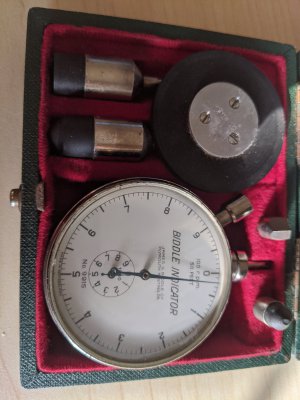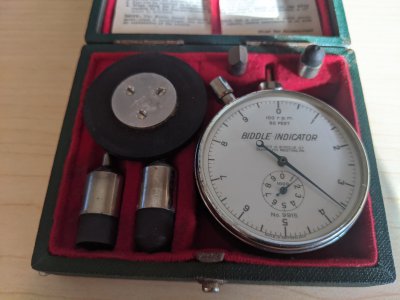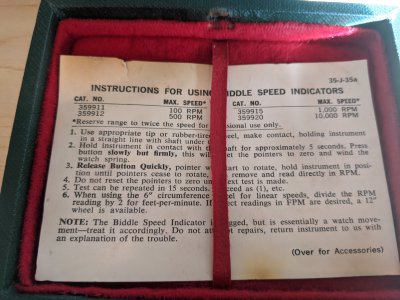- Joined
- Aug 3, 2017
- Messages
- 2,437
SO, I saw this interesting tool on Keith Rucker's odds/ends video, and decided I needed to have one! I'd previously purchased a digital one (that reads a white mark on the thing), and am pretty unhappy with it at lower RPMs, and the Starrett 104 tachometer is TERRIBLE, as it doesn't actually show RPM (it just counts rotations, and YOU need to do the timing). The B&S version of the Starrett is similar, though slightly better.
Enter, The Biddle Speed Indicator, available in 4 ranges[0]! It has a stop-watch mechanism that resets/enables/disables the indicators! So, all you do is hold the tip against a rotating item, press the button, and 6 seconds later (when the needle stops moving!), you have your RPM (or ft/sec /2 [1]).
I jumped on ebay and found this guy for $30 shipped. I'm incredibly impressed with the quality/feel of the mechanism and think this is pretty darn useful! I ended up spending another $50 today for the 10k RPM one, as this one only reads up to 1k RPM!
[0]: According to the card, it is available in the 9911, 9912, 9915, and 9920. The 9910 reads up to 100 RPM, 9912 reads up to 500 RPM, 9915 (this one!) reads up to 1k RPM, and the 9920 reads up to 10k RPM! I've found pictures of each (a non-operational 9911 is available on ebay, which seems like the rarest, the 9912 is slightly more available, and the 9915 is most available).
The 9911 has 1/10th RPM increments, the 9912 and 9915 have 1 RPM increments, and the 9920 has 10 RPM increments(note the card says you can do 2x the RPM occasionally):
[1]: It comes with a 6" circumference wheel for measuring linear travel. SO, the linear speed indicated is actually 2x the actual, as the paperwork says. Apparently a 12" circumference wheel was available for those who need to save their divide-by-2 skills! The FPM reading isn't indicated nicely on the face, particularly since the relationship between the two is odd. Though, I don't see linear speed as nearly as useful to me, so I'm not paying particular attention to it.
Enter, The Biddle Speed Indicator, available in 4 ranges[0]! It has a stop-watch mechanism that resets/enables/disables the indicators! So, all you do is hold the tip against a rotating item, press the button, and 6 seconds later (when the needle stops moving!), you have your RPM (or ft/sec /2 [1]).
I jumped on ebay and found this guy for $30 shipped. I'm incredibly impressed with the quality/feel of the mechanism and think this is pretty darn useful! I ended up spending another $50 today for the 10k RPM one, as this one only reads up to 1k RPM!
[0]: According to the card, it is available in the 9911, 9912, 9915, and 9920. The 9910 reads up to 100 RPM, 9912 reads up to 500 RPM, 9915 (this one!) reads up to 1k RPM, and the 9920 reads up to 10k RPM! I've found pictures of each (a non-operational 9911 is available on ebay, which seems like the rarest, the 9912 is slightly more available, and the 9915 is most available).
The 9911 has 1/10th RPM increments, the 9912 and 9915 have 1 RPM increments, and the 9920 has 10 RPM increments(note the card says you can do 2x the RPM occasionally):
| Model | Top RPM | RPM Increments |
| 9911 | 100 | 1/10th |
| 9912 | 500 | 1 |
| 9915 | 1000 | 1 |
| 9920 | 10,000 | 10 |
[1]: It comes with a 6" circumference wheel for measuring linear travel. SO, the linear speed indicated is actually 2x the actual, as the paperwork says. Apparently a 12" circumference wheel was available for those who need to save their divide-by-2 skills! The FPM reading isn't indicated nicely on the face, particularly since the relationship between the two is odd. Though, I don't see linear speed as nearly as useful to me, so I'm not paying particular attention to it.




